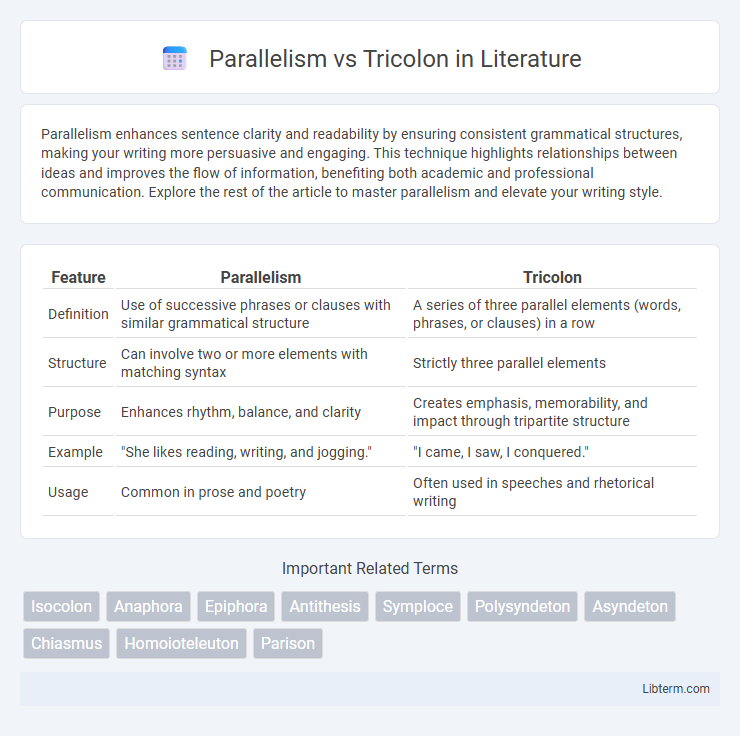Parallelism enhances sentence clarity and readability by ensuring consistent grammatical structures, making your writing more persuasive and engaging. This technique highlights relationships between ideas and improves the flow of information, benefiting both academic and professional communication. Explore the rest of the article to master parallelism and elevate your writing style.
Table of Comparison
| Feature | Parallelism | Tricolon |
|---|---|---|
| Definition | Use of successive phrases or clauses with similar grammatical structure | A series of three parallel elements (words, phrases, or clauses) in a row |
| Structure | Can involve two or more elements with matching syntax | Strictly three parallel elements |
| Purpose | Enhances rhythm, balance, and clarity | Creates emphasis, memorability, and impact through tripartite structure |
| Example | "She likes reading, writing, and jogging." | "I came, I saw, I conquered." |
| Usage | Common in prose and poetry | Often used in speeches and rhetorical writing |
Understanding Parallelism: Definition and Purpose
Parallelism involves the repetition of grammatical structures to create rhythm and balance in writing, enhancing clarity and emphasis. It serves the purpose of making ideas more memorable and persuasive by aligning similar elements within sentences or phrases. Understanding parallelism enables effective communication by ensuring consistency and reinforcing key messages through structural harmony.
What Is a Tricolon? Exploring Its Structure
A tricolon is a rhetorical device consisting of three parallel elements of equal length, creating a memorable and rhythmic effect in speech or writing. It employs three coordinated phrases or clauses, each balanced in structure, to emphasize a point or create a powerful impact. Unlike general parallelism, which can involve any number of similar grammatical constructions, a tricolon specifically requires the presence of three parallel components arranged consecutively.
Historical Origins: Parallelism and Tricolon in Rhetoric
Parallelism and tricolon both trace their origins to classical rhetoric, with Aristotle and Cicero extensively discussing parallel structures as a means to enhance clarity and persuasiveness. Parallelism involves the repetition of grammatical structures to create rhythm and balance, while tricolon is a specific form of parallelism featuring three parallel elements, often used for emphasis and memorability. Ancient Roman and Greek orators refined these devices to improve speech impact, embedding them deeply in the tradition of rhetorical education and persuasive discourse.
Key Differences Between Parallelism and Tricolon
Parallelism structures sentences by repeating grammatical elements to create rhythm and clarity, while tricolon specifically requires three parallel components to form a powerful, memorable phrase. The key difference lies in scope: parallelism can involve any number of repeated elements, but tricolon mandates exactly three, enhancing emphasis and persuasion. Both techniques improve readability and rhetorical effect, yet tricolon's tripartite form uniquely amplifies the impact of the message.
Functions of Parallelism in Persuasive Writing
Parallelism enhances clarity and rhythm in persuasive writing by creating balanced phrases that emphasize key ideas, making arguments more memorable and impactful. It reinforces logical flow, aiding readers' understanding and retention of complex concepts by presenting them in a structured, repetitive pattern. Tricolon, a specific form of parallelism comprising three parallel elements, intensifies persuasion through its rhythmic and emphatic effect, driving points home with increased force.
The Power of Three: Impact of Tricolon in Communication
Tricolon leverages the power of three parallel elements to create rhythm, enhance memorability, and emphasize key messages in communication. This rhetorical device intensifies the impact of a statement by structuring ideas in a concise, balanced sequence, making content more persuasive and engaging. Unlike general parallelism that involves repetition of grammatical structures, tricolon specifically utilizes a trio of phrases or words, maximizing the psychological effect on audiences.
Famous Examples: Parallelism vs Tricolon in Literature
Parallelism in literature uses balanced structures in phrases or sentences to create rhythm and enhance meaning, exemplified by Charles Dickens' "It was the best of times, it was the worst of times." Tricolon, a specific form of parallelism comprising three parallel elements, is famously illustrated in Julius Caesar's "Veni, Vidi, Vici," emphasizing concise and powerful expression. Both techniques amplify rhetorical impact by reinforcing ideas through structured repetition, with tricolon often delivering a memorable and emphatic effect.
When to Use Parallelism vs Tricolon in Your Writing
Use parallelism to create balance and rhythm within sentences by repeating grammatical structures, enhancing clarity and flow in your writing. Employ tricolon specifically when you want to emphasize a point with a series of three parallel elements, as this structure is known for its memorable and persuasive effect. Opt for parallelism in broader contexts for cohesion, and reserve tricolon for impactful statements or rhetorical flourishes.
Common Pitfalls: Avoiding Overuse and Confusion
Overusing parallelism and tricolon can dilute the impact of your writing, leading to redundancy and reader fatigue. Confusing the two by mixing unequal elements in a tricolon disrupts rhythm and clarity, undermining the intended emphasis. Effective use requires balancing repetition with variation, ensuring each element is logically connected and proportionate to maintain persuasive and engaging prose.
Enhancing Style: Blending Parallelism and Tricolon Effectively
Blending parallelism and tricolon effectively enhances rhetorical style by creating rhythm and emphasis through balanced structures of three related elements. Parallelism ensures grammatical consistency across phrases or clauses, while tricolon precisely employs three parallel components to maximize impact and memorability. Mastery of combining these devices strengthens persuasive writing and speech by fostering clarity and engaging the audience.
Parallelism Infographic

 libterm.com
libterm.com